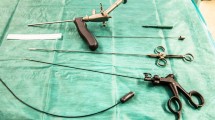Abstract
Aim
To examine the results of our minimal invasive treatment for pilonidal disease.
Methods
Total 83 patients treated by pit excision and consecutive phenol applications on an outpatient setting. All procedures were performed under local anesthesia, without any preoperative testing, colon cleansing, prophylactic antibiotics or sedation. A pit excision (mean length 1.3 ± 0.5 cm) including several close midline orifices was done. Separated pit excisions were done to the remaining midline and lateral orifices. Sinus cavity was cleared of hair and debris, and the walls of the cavity were sclerosed using a cotton bud dipped in 80 % liquid phenol. Phenolization was repeated twice on day one and seven.
Results
Mean procedure time was 22.2 ± 7.4 min. Rates of patients who did not required analgesics at first, second, third and fourth days after surgery were 58, 85, 91 and 100 %, respectively. All the patients returned to work/school after 3 days. Mean wound closure time was 28.5 ± 14.9 days. Total 86.7 % of the patients were asymptomatic after a mean 25.7 ± 8.5 months follow-up.
Conclusion
Simple pit excision and sclerosing the pilonidal sinus cavity consecutively was an effective and minimal invasive method for relief of pilonidal symptoms.


Similar content being viewed by others
References
Kayaalp C, Olmez A, Aydin C, Piskin T, Kahraman L (2010) Investigation of a one-time phenol application for pilonidal disease. Med Princ Pract 19:216–217
Kayaalp C, Aydin C (2009) Review of phenol treatment in sacrococcygeal pilonidal disease. Tech Coloproctol 13:189–193
Lord PH, Millar DM (1965) Pilonidal sinus: a simple treatment. Br J Surg 52:298–300
Gips M, Melki Y, Salem L, Weil R, Sulkes J (2008) Minimal surgery for pilonidal disease using trephines: description of a new technique and long-term outcomes in 1,358 patients. Dis Colon Rectum 51:1656–1662
Iesalnieks I, Deimel S, Kienle K, Schlitt HJ, Zülke C (2011) Pit-picking surgery for pilonidal disease. Chirurg 82:927–931
Kayaalp C, Olmez A, Aydin C, Piskin T (2009) Tumescent local anesthesia for excision and flap procedures in treatment of pilonidal disease. Dis Colon Rectum 52:1780–1783
Al-Khamis A, McCallum I, King PM, Bruce J (2010) Healing by primary versus secondary intention after surgical treatment for pilonidal sinus. Cochrane Database Syst Rev Jan 20:CD006213
Kaymakcioglu N, Yagci G, Simsek A et al (2005) Treatment of pilonidal sinüs by phenol application and factors affecting the recurrence. Tech Coloproctol 9:21–24
Dogru O, Camci C, Aygen E, Girgin M, Topuz O (2004) Pilonidal sinus treated with crystallized phenol: an eight-year experience. Dis Colon Rectum 47:1934–1938
Maurıce BA, Greenwood RK (1964) A conservative treatment of pilonidal sinus. Br J Surg 51:510–512
Stewart TJ, Bell M (1969) The treatment of pilonidal sinus by phenol injection. Ulster Med J 38:167–171
Stephens FO, Sloane DR (1969) Conservative management of pilonidal sinus. Surg Gynecol Obstet 129:786–788
Hegge HG, Vos GA, Patka P, Hoitsma HF (1987) Treatment of complicated or infected pilonidal sinus disease by local application of phenol. Surgery 102:52–54
Kelly SB, Graham WJ (1989) Treatment of pilonidal sinus by phenol injection. Ulster Med J 58:56–59
Stansby G, Greatorex R (1989) Phenol treatment of pilonidal sinuses of the natal cleft. Br J Surg 76:729–730
Vara-Thorbeck R, Mekinassi K, Berchid S (1990) Phenol treatment of pilonidal sinuses. Zentralbl Chir 115:777–780
Schneider IH, Thaler K, Köckerling F (1994) Treatment of pilonidal sinuses by phenol injections. Int J Colorectal Dis 9:200–202
Sakçak I, Avşar FM, Coşgun E (2010) Comparison of the application of low concentration and 80 % phenol solution in pilonidal sinus disease. JRSM Short Rep 30:5
Dag A, Colak T, Turkmenoglu O, Sozutek A, Gundogdu R (2012) Phenol procedure for pilonidal sinus disease and risk factors for treatment failure. Surgery 151:113–117
Conflict of interest
The authors declare that no conflict of interest exists.
Author information
Authors and Affiliations
Corresponding author
Rights and permissions
About this article
Cite this article
Olmez, A., Kayaalp, C. & Aydin, C. Treatment of pilonidal disease by combination of pit excision and phenol application. Tech Coloproctol 17, 201–206 (2013). https://doi.org/10.1007/s10151-012-0903-9
Received:
Accepted:
Published:
Issue Date:
DOI: https://doi.org/10.1007/s10151-012-0903-9




